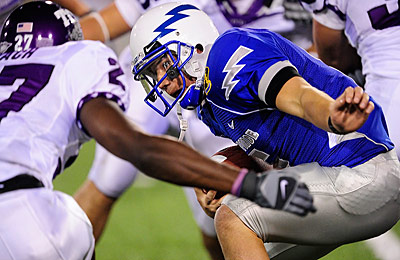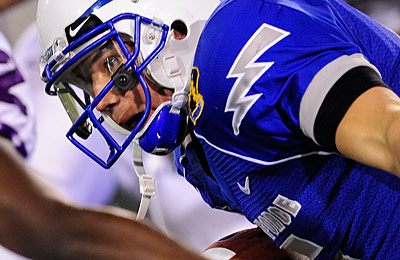|
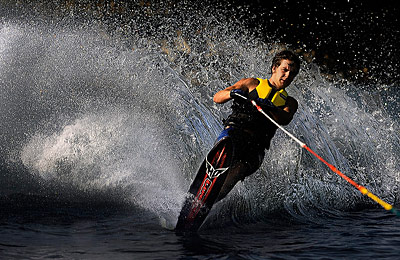 Question #1; “I shoot outdoor sports only, why would I need high ISOs like 1600, 3200 or 6400?” Question #1; “I shoot outdoor sports only, why would I need high ISOs like 1600, 3200 or 6400?”
Answer/Image #1 Rooster Tail … I of course shoot many outdoor sports as well and find that 1/1000 of a second shutter speed is still too slow to perfectly freeze all the action of many sports. Whether it is dirt thrown from the tires of a motorcycle, grass kicked up by a football player, ice chips spraying from the skates of a hockey player, or as with this image of a water skier, freezing all the water droplets, a higher ISO will enable the photographer to use faster shutter speeds above the usual 1/1000. Flying elements like water, ice, sand, dirt etc tend to look better when completely frozen in mid air. The Nikon D3 introduces the idea of ISO400, 500, 640, or even 800 as being considered LOW ISO settings because there is virtually no noise. A clean higher ISO also enables the photographer to use a larger aperture setting for a broader depth of field which is especially welcome when using long focal length lenses of 400, 500 and 600mm. Nikon D3, ISO1000, 1/3200 at f5.6, Nikon 200-400 G VR Zoom Lens, Lexar 8G Flash Card.
|
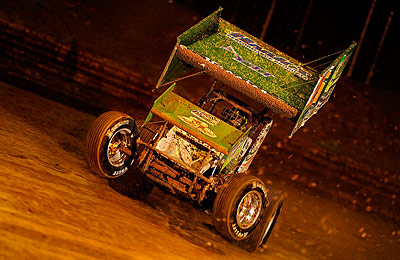 Question #2; “Dude, is ISO6400 completely noiseless…. and if so, like why wouldn’t I use it all the time, like in bright sunshine?” Question #2; “Dude, is ISO6400 completely noiseless…. and if so, like why wouldn’t I use it all the time, like in bright sunshine?”
Answer/Image #2 Revved Up … No, ISO6400 is not completely noiseless. There is some noise at ISO6400. The noise level in the lit areas is very low and extremely clean. The darker shadow areas of the picture will have a slightly higher amount of noise than the lit areas. Some photographers have compared the ISO6400 noise level of the D3 as being similar to the ISO400 setting in a D2Xs. As far as using ISO6400 in bright sunshine I would still rather use an ISO setting according to the lighting conditions, but understand that a low ISO can now easily include ISO400 – ISO800. Images shot at ISO100 (LOW 1) up to ISO800 are stunning regarding quality and absence of noise. The ISO settings of 1000-1250 are equally beautiful in quality and nearly noiseless, especially in the lit areas of the picture. The terrific image quality continues with ISO1600, 3200, and 6400 but understand that although the noise level is still incredibly low there is a slight increase as the ISO setting increases. ISO1600 looks better than ISO3200 and ISO3200 looks better than ISO6400. For the sports photographer I noted some scenarios in the November 2007 edition of Workshop at the Ranch that might warrant using very high ISO settings even in bright day light. These scenarios are explained in detail within that article … you might want to re-read that article. Nikon D3, ISO6400, 1/640 at f2, Nikon 200mm G VR f2 Lens, WB 6670, Lexar 8G Flash Card.
|
Question #3; “Is the high ISO setting of “HI 1″ usable or do I need to go no higher than 6400?”
Answer/Image #3A Falcon Run … As I wrote about in last month’s article, the “HI 1” ISO feature equates to ISO 12,800. This is a number photographers can not even think in terms of ……. I personally had to think about what the ISO number above 6400 would even be! Yes, it is usable,…and should publish well in newspapers or magazines and make quality prints. Many people are talking about what the D3 will do for the photographer, but a highlight might be what the camera will do for the general public. Let me explain … The High School athlete is a great athlete. They make great pictures, really great pictures, but we, the general public, seldom see them published because the indoor gymnasium or night football game is too dark to use a fast shutter speed to stop the action and still have good publishable quality. The D3 will allow the photographer to make good and even excellent pictures in dreadful lighting situations. ISO 6400 does look better than 12,800 but as this image shows as well as the image of football action I posted in November’s Workshop at the Ranch article, ISO 12,800 is a reality. Nikon D3, ISO12,800 (HI 1), 1/1000 at f5.6, Nikon 400 G VR Lens with TC14E 1.4 Teleconverter, 3D Focus Tracking, WB Auto, Lexar 8G Flash Card.
Image #3B Falcon Run (close up cropped detail) … I have cropped the image for a closer study. This cropped enlargement illustrates the clean, low noise performance at ISO12,800 (HI 1). It is also note worthy that the 3D Focus Tracking System works well. Its ability to track a player through a maze of identical teammates jerseys is no less that remarkable.
|
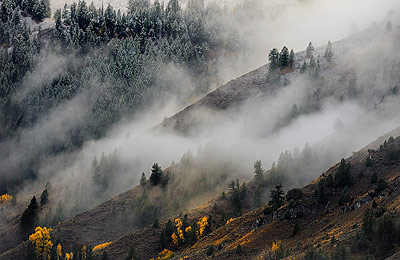 Question #4 “I shoot landscapes and nature scenes for both publication and print making,…I have a D2Xs, what does the D3 offer me?” Question #4 “I shoot landscapes and nature scenes for both publication and print making,…I have a D2Xs, what does the D3 offer me?”
Answer/Image #4 Fog Along the Hoback … I do not consider myself to be an expert when it comes to landscape and nature photography, but I can confidently say that the D3 offers better pixel quality, sharper details, greater Dynamic Range, and more precise color rendering with quality than a D2Xs. I use an Epson Pro Stylus 7600 printer and Epson Premium Luster paper for my in-house printmaking. I make 16X24 and 24X36 inch prints and it was evident that the prints I have made with the D3 look better than those prints made from a D2Xs file. You WILL notice the improvement. This is why I said in the November 2007 Workshop at the Ranch article that the 12.1 megapixel Nikon FX Format CMOS Imaging Sensor is the key to the D3’s success. The file quality that the D3 produces looks more like a file from a 17 megapixel camera. That should be reason enough to consider this camera for any subject but especially for those seeking published magazine covers and double page spreads, and those who make gallery print enlargements. Keep in mind the extremely clean ISO settings of 400, 500, 640 and 800 while even 1000-1600 look fantastic and will enable the landscape, nature and wildlife photographers to work in lower light conditions and use faster shutter speeds or larger aperture settings. Nikon D3, ISO800, 1/320 at f7.1, Nikon 200-400 G VR Zoom Lens, WB 6670K, Lexar 8G Flash Card.
|
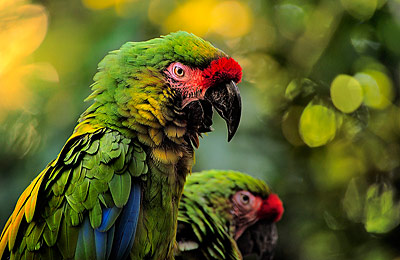 Question #5 “In last months article of Workshop at the Ranch you mentioned that you have purchased some new equipment like the Nikon 1.7 converter and a 70-300mm f4.5-5.6 G VR Zoom Lens,..Why? ……… are you using the two together?” Question #5 “In last months article of Workshop at the Ranch you mentioned that you have purchased some new equipment like the Nikon 1.7 converter and a 70-300mm f4.5-5.6 G VR Zoom Lens,..Why? ……… are you using the two together?”
Answer/Image #5 Parrot Profile … No, the TC17E 1.7 Teleconverter and the Nikon 70-300mm Lens do not connect. The two pieces of equipment cannot be used together. I was merely pointing out that lenses with slower apertures will become more useful because the photographer can compensate for the slower aperture by using a higher ISO and not diminish the quality of the picture with excessive noise. Slower aperture lenses are smaller, lighter in weight, and sometimes less expensive than lenses boasting apertures of f2.8 or f2. Photographers who are active in the field hiking, rock climbing, mountaineering, following wildlife, or those shooting from confined locations like a boat, airplane, or even a crowded market place in a foreign country need smaller/lighter lenses but have in the past sacrificed image quality because of the need to use higher ISO settings to compensate for the slower aperture. The 70-300mm G VR Zoom Lens with its variable aperture of f4.5-f5.6 would normally be considered a slower lens but when mounted to a D3 it becomes more acceptable because I can increase the ISO and not sacrifice quality. This profile of a parrot was photographed with the Nikon 70-300mm f4.5-5.6 G VR Zoom Lens at its maximum focal length of 300mm which results in an apeture of f5.6. There is almost no light left in the day and the dense canopy of trees and vegetation made for a very dark environment. The Nikon 70-300 G VR Zoom Lens worked very well. It is small and light weight. It is very sharp edge to edge even at 300mm and has fast focusing and VR stabilization. Before the D3 came along I would have used a low ISO of 400 to maintain clean publishable quality. The “old” solution would have been a 300mm f2.8 lens and an exposure of 1/30 at f2.8 (that would require a tripod or monopod….more gear/weight.) This is a large and heavy lens for someone to carry for 10 hours while hiking. The D3 allowed me to increase the ISO to 3200 and retain excellent image quality with a small amount of noise that looks similar to a D2Xs file at ISO400. I can now easily hand hold the camera with the smaller 70-300mm lens and shoot at an exposure of 1/60 at f5.6. Nikon D3, ISO3200, 1/60 at f5.6, Nikon 70-300 f4.5-f5.6 G VR Zoom Lens (I zoomed to 300mm f5.6), WB Auto A6 (there are optional settings for the Auto WB mode that can add warmth or coolness to an Auto WB setting, A1-A6 adds warmth; A6 being the warmest, while B1-B6 adds coolness; B6 being the coolest), Lexar 8G Flash Card. For those photographers who require extremely long focal lengths for sports coverage or wildlife adding a Nikon TC17E 1.7 Teleconverter to a lens like a 400mm f2.8 produces a tremendous focal length of 650mm but a slow wide open aperture of f4.8. The D3 allows the increase of ISO which compensates for the slower aperture when adding the 1.7 Teleconverter and still retains great image quality. The use of a teleconverter now becomes useful even for a nighttime sporting event like football and baseball or for wildlife photography under cloudy skies and inclement weather conditions. |
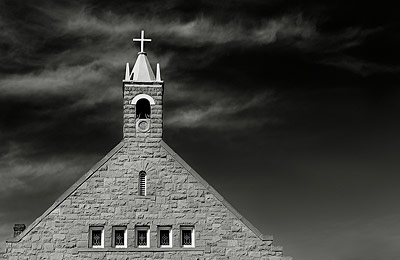 Question #6 “Does the D3 Picture Control feature replace Photoshop?” Question #6 “Does the D3 Picture Control feature replace Photoshop?”
Answer/Image #6 Church at Trinidad … No, I don’t think the Picture Control options in the Nikon D3 will replace Photoshop or Nikon Capture NX, but I do believe some rendering can be done in the D3 camera at the moment of capture and less enhancement in post processing with the computer. That is a very important time saver for many photographers. There have always been rendering enhancement and color mode options in digital cameras. With the exception of White Balance I, for the most part, have not made use of these options. The reason was two fold for me; 1. Enhancements that were programmable within previous cameras tended to diminish the quality of the image slightly. Extra saturation or extra sharpening seemed to hurt the picture quality more than helping it. Keep in mind I’m talking about pictures that are being published or printed large. The Nikon D200 was the first camera I occasionally used the Vivid setting and was pleased with the results but only with ISO settings of ISO400 or less. 2. Most publications and editors I work with usually require the RAW/NEF file for publication and so there was no point in adding enhancements because the magazine or book would do so on their end. The Nikon D3 has several choices in the Picture Control menu. I have been using Vivid because it seems to replicate Velvia film in its colors and tonality. But if one goes deeper into the menu there are some very precise controls for Sharpening, Contrast, Brightness, Saturation, and Hue. Although I’m still experimenting with these “in camera” rendering tools one thing seems clear, that the quality of the image is not diminished by increasing or decreasing the enhancements even at the higher ISO settings. Perhaps this is because of the Nikon FX Format CMOS Imaging Sensor and the extremely low noise capabilities. At any rate, the proof is in the printing/publishing so to speak and I like the results I’m seeing. If you are a photographer who enjoys laboring over a picture for hours in Photoshop then Picture Control is not for you. I, on the other hand, like to take more pictures and spend less time at the computer. Using Picture Control enhancements will probably be a learning curve for both the photographer and editor alike. The Picture Control menu also offers a Sepia tone and Monochromatic (Black and White) setting, each with a variety of Tone and Filter options. Nikon D3, ISO100(Lo 1), 1/640 at f9, Nikon 24-70 Lens, WB 6250K, Picture Control Monochromatic with Sharpening +3, Contrast +2, Brightness +1, Filter Green, Toning Black & White, Lexar 8G Flash Card. |
![]() Hi and welcome to this edition of Workshop at the Ranch. Well, last month’s articles on the new Nikon D3 camera in Workshop at the Ranch and On The Road created a lot of traffic on my website. In fact, there were so many people logging on at one time that the server closed down several times because of the overload. By the third day of posting, the site had far surpassed previous numbers of unique visitors. There were many email comments and questions regarding the new D3 and so I thought I would address a few questions and show a few more images.
Hi and welcome to this edition of Workshop at the Ranch. Well, last month’s articles on the new Nikon D3 camera in Workshop at the Ranch and On The Road created a lot of traffic on my website. In fact, there were so many people logging on at one time that the server closed down several times because of the overload. By the third day of posting, the site had far surpassed previous numbers of unique visitors. There were many email comments and questions regarding the new D3 and so I thought I would address a few questions and show a few more images. 



